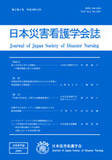Japanese
English
- 有料閲覧
- Abstract 文献概要
- 参考文献 Reference
- サイト内被引用 Cited by
抄録
感染制御のあり方について検討するための基礎的調査として、医療従事者の感染防護具着用が人の印象に与える影響と事前情報との関連性について実験的手法により調査した。事前にYG性格検査の自記式調査を行い、前後で感染症のリスクイメージ、対人認知尺度の質問紙調査を行った。白衣姿の医療従事者3人から10m離れた地点より、接近法にてパーソナルスペース(距離・脈拍・瞬き回数)を測定した。その後、3つの情報①SARSについて②SARSと感染防御について③マザーテレサ(統制群)についてのいずれか1つのDVDを視聴してもらい、再度感染防護具着用のSARSスタッフに対するパーソナルスペースを計測した。対象は、教育系学部大学生の83名である。
感染防護具の着用により、SARSリスクの恐ろしさイメージは低下し、未知性イメージは上昇した。医師の活動性イメージが低下し、逆に看護師の社会的望ましさイメージの上昇を認めた。限界点における白衣時の対人距離は133.71cmで、感染防護具装着後の調整平均値は、統制群が158.70±17.02(±SE)cm、感染防御群217.07±17.94cm、SARS群204.48±16.83cmと有意に拡大した(p<0.001)。ケア環境における対人距離としては不適切な広がりを認め、同時に瞬き回数の低下を認め、防護具が未知であるゆえの反応と推測された。さらに、情報(DVD)の条件間にも差を認め、統制群に比べて感染防御群の方が有意に距離が拡大した(p<.05)。専門的な情報提供が逆に感染症に対する脅威を与える可能性が推測された。
Abstract
As a basic study on determining methods of infection control, the relationship between the effects of wearing infection control personal protective equipment on the impression of medical personnel on others and prior information was investigated using experimental techniques. A self-administered YG personality test was conducted beforehand, and the risk perception of infections and scale of personality perception were conducted before and after the experiment. Personal space(distance, pulse, blink frequency)was measured using an approximation method starting at a point 10m away from three medical personnel wearing plain white clothing. Subsequently, subjects were divided into three information groups, specifically 1)SARS, 2)SARS and infection control, and 3)Mother Theresa(controls), and watched a DVD on the respective information. Personal space regarding SARS staff wearing infection control personal protective equipment was measured again. Subjects were 83 university students in the Department of Education.
Use of infection control personal protective equipment lowered the dread factor and increased the unknown factor regarding the risk of SARS. The activity factor of doctors decreased, while conversely, the social desirability factor of nurses increased. The limit for interpersonal distance from personnel wearing plain white gowns was 133.71 cm , and the adjusted means after the personnel wore infection control personal protective equipment were significantly greater(p<0.001), as follows: 158.70±17.02 (±SE)cm in controls, 217.07±17.94cm in the infection control group, and 204.48± 16.83cm in the SARS group. These increases in interpersonal distance were considered inappropriate in the care environment, and were accompanied by decreases in blink frequency. These changes were thought to be responses to the unknown personal protective equipment. In addition, differences were also observed between different types of information(DVD), and distance was significantly greater(p<.05)for the infection control group relative to controls. These findings suggest the possibility that the provision of specialized information may actually increase the perceived threat of infections.
Copyright © 2007, Japan Society of Disaster Nursing All rights reserved.


